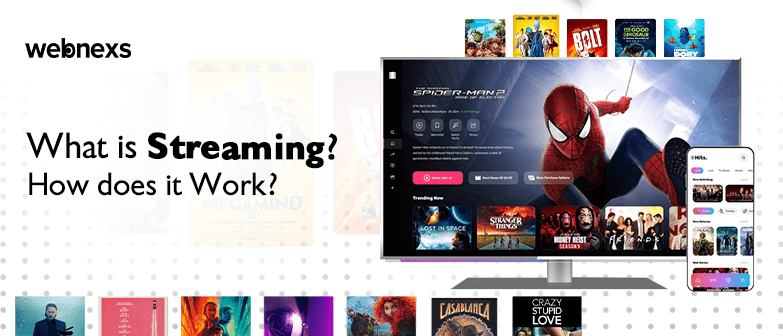Introduction:
Streaming has taken the entertainment industry by storm in recent years, and for good reason. It provides a convenient and cost-effective way for people to access movies, TV shows, and music. However, many people are still confused about what streaming is and how it works. In this article, we will comprehensively explain what is streaming, how it works, and its advantages and disadvantages.
What is Streaming?
Streaming is a way of delivering multimedia content, such as movies, TV shows, and music, over the internet. Rather than downloading a file to your device and watching it offline, you can stream content on demand, which means you can watch or listen to it in real-time. This technology has become incredibly popular in recent years because of its convenience and flexibility.
How Does Streaming Work?
Streaming is transmitting audio or video data over the internet to be played in real-time on a device. To make this possible, streaming relies on servers that host the media content and deliver it to the end user’s device.
When a user wants to stream a video or audio file, the data is first encoded into a format that is suitable for streaming. The encoded data is then sent to a streaming server that hosts the content. The streaming server is responsible for transmitting the data to the end user’s device in real-time.
To receive the stream, the user’s device must connect to the streaming server and request the data. The user’s device then receives the stream and decodes the data to play it back in real-time. The user can pause, rewind, or fast-forward the content while it is being streamed.
Internet speed plays a crucial role in the quality of the streaming experience. If the user’s internet connection is too slow, the stream may not be able to keep up with the requested bitrate, causing buffering or stuttering. On the other hand, a faster internet connection can allow for smoother playback and higher-quality streaming.
Overall, streaming has revolutionized the way we consume media and has become an essential part of our daily lives. With the increasing availability of high-speed internet and advancements in streaming technology, the future of streaming looks bright.
Quality of Streaming Factors that affect streaming quality
Several factors, including bandwidth, internet speed, network congestion, and more affect streaming quality.
Bandwidth refers to the amount of data that can be transmitted over a network at a time. The higher the bandwidth, the better the quality of the streaming content.
Internet speed is also a critical factor in streaming quality. A high-speed internet connection is necessary for uninterrupted streaming. Slow internet speeds can cause buffering and poor video quality.
Network congestion can also impact streaming quality. When many users are streaming at the same time, the network can become congested, causing buffering and poor quality.
How to optimize streaming quality
To optimize streaming quality, it is recommended to use a wired internet connection instead of Wi-Fi, as wired connections are more stable and faster. Closing other applications that use bandwidth can also help to improve streaming quality.
Streaming resolution and bitrate
The streaming resolution and bitrate are also important factors in streaming quality. Resolution refers to the number of pixels displayed on the screen, and a higher resolution means better quality. Bitrate refers to the amount of data transferred per second and affects the video’s overall quality and smoothness. Higher bitrates can cause better quality, but they also require higher bandwidth and internet speeds.
How to Choose the Right Streaming Service
Choosing the right streaming service can be overwhelming, given the number of options available. Here are some factors to consider when choosing a streaming service:
- Content: Look for a service that offers the type of content you’re interested in. If you’re into movies, look for a service that has a vast movie library. If you’re into TV shows, look for a service that has a wide range of TV shows.
- Price: Consider the cost of the service and whether it fits within your budget. Most services offer different subscription tiers, so you can choose the one that best suits your needs.
- User experience: Look for a service that is easy to use and navigate. You don’t want to waste time trying to figure out how to find the content you want to watch.
- Device compatibility: Make sure the service is compatible with the devices you own, like your TV, smartphone, or tablet.
Streaming Security:
Streaming has become a popular way to consume media, but it is not without security risks. Here are some security risks associated with streaming:
Malware and viruses: Streaming websites and apps can sometimes be infected with malware or viruses. It can download these onto your device without your knowledge, which can lead to data breaches or theft.
Geolocation tracking: Some streaming services track user data, including location data, which can be used for targeted advertising or even identity theft.
To protect against these risks, here are some measures you can take:
Use a VPN: A VPN (a virtual private network) encrypts your internet traffic and hides your IP address, which can protect your privacy and prevent hackers from intercepting your data.
Use anti-virus software: Install anti-virus software on your device to protect against malware and viruses.
Use legitimate streaming services: Stick to well-known, legitimate streaming services to reduce the risk of encountering phishing scams or other security threats.
Be cautious of suspicious links: Avoid clicking on suspicious links or downloading apps or files from unknown sources.
By taking these precautions, you can enjoy the benefits of streaming while minimizing the associated security risks.
The future of streaming
Here are some predictions for the future of streaming technology:
Increased adoption of 5G networks: With the rollout of 5G networks, streaming will become faster and more reliable, allowing for higher quality video and less buffering.
Expansion of augmented and virtual reality streaming: As augmented and virtual reality technologies become more advanced, we can expect to see more streaming content in these formats.
Personalization and interactivity: Streaming services will continue to personalize content recommendations and offer interactive features, such as live chats and audience polls.
More original content: Streaming services will continue to produce and distribute their own original content, further disrupting the traditional entertainment industry.
Continued growth in international markets: As internet access continues to spread globally, streaming services will have more opportunities to expand into new markets.
While streaming has already had a significant impact on the entertainment industry, it will continue to shape the way we consume media in the future. However, there are potential challenges to be faced, such as increasing competition among. Streaming services and potential regulatory changes. It will be important for companies to continue to innovate and adapt in order to stay relevant in this rapidly evolving landscape.
Types of Streaming:
There are three main types of streaming: live streaming, on-demand streaming, and progressive streaming.
- Audio streaming: This involves the transmission of audio content over the internet in real-time, allowing users to listen to music, podcasts, and other audio content on-demand. Popular audio streaming services include Spotify, Apple Music, and Pandora.
- Video streaming: This involves the transmission of video content over the internet, allowing users to watch movies, TV shows, and other video content on-demand. Popular video streaming services include Netflix, Hulu, and Amazon Prime Video.
- Live streaming: This involves the real-time transmission of audio or video content over the internet as it is happening, allowing users to watch or listen to live events as they occur. Live streaming is used for sporting events, news broadcasts, concerts, and other live events.
- On-demand streaming: This involves the transmission of audio or video content over the internet, allowing users to access and watch or listen to content whenever they want. On-demand streaming services are popular because they allow users to watch or listen to content without having to download it first, saving time and storage space.
Advantages of Streaming:
- Convenience:
One of the biggest advantages of streaming is its convenience. With on-demand streaming, you can watch movies and TV shows at any time, from anywhere, as long as you have an internet connection.
- Cost-effective:
Streaming services are typically much cheaper than cable TV packages, making them a cost-effective option for entertainment.
- High-quality:
Streaming services offer high-quality video and audio, with many services offering 4K and HDR content.
Disadvantages of Streaming:
- Internet Connection:
Streaming requires a stable and fast internet connection. If your internet is slow or unreliable, your streaming experience may be affected.
- Limited Availability:
Not all movies and TV shows are available on every streaming service, which can be frustrating for viewers who want to watch a particular title.
- Dependence on a Device:
Streaming services require a device such as a smartphone, tablet, or smart TV to access content, which can be a disadvantage for those who do not have access to these devices.
Conclusion
Streaming has revolutionized the way we consume entertainment, and it’s here to stay. With the advantages of convenience and cost-effectiveness, it’s no wonder that more and more people are opting for streaming services over traditional TV and movie distribution models. As streaming continues to evolve, we can expect to see more competition and innovation in the space, which will benefit consumers with more choices and better content.


